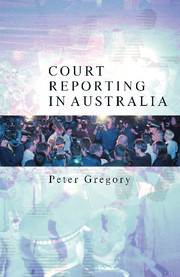Book contents
- Frontmatter
- Contents
- Figures and Tables
- Acknowledgments
- Introduction
- Chapter 1 The Court System: An Overview
- Chapter 2 Gaining Information
- Chapter 3 Contempt
- Chapter 4 Defamation
- Chapter 5 Writing the (Newspaper) Story
- Chapter 6 Subediting and Photography
- Chapter 7 Television and Radio
- Chapter 8 Human Relations and Ethics
- Chapter 9 An Atypical Friday at Court
- Chapter 10 Suppression Orders
- Chapter 11 Future Directions and Issues
- Bibliography
- Index
Chapter 7 - Television and Radio
Published online by Cambridge University Press: 22 September 2009
- Frontmatter
- Contents
- Figures and Tables
- Acknowledgments
- Introduction
- Chapter 1 The Court System: An Overview
- Chapter 2 Gaining Information
- Chapter 3 Contempt
- Chapter 4 Defamation
- Chapter 5 Writing the (Newspaper) Story
- Chapter 6 Subediting and Photography
- Chapter 7 Television and Radio
- Chapter 8 Human Relations and Ethics
- Chapter 9 An Atypical Friday at Court
- Chapter 10 Suppression Orders
- Chapter 11 Future Directions and Issues
- Bibliography
- Index
Summary
Television and the courts
It is a visual cliché, but the rolling media maul, with camera operators and technicians backing into traffic, seems to sum up the image of television at the courts. Television news needs pictures to present stories and courts traditionally provide few. Cameras are not usually allowed in courtrooms, although there are many examples of judges and lawyers being filmed at the start of hearings. Camera access is strictly controlled and usually does not extend to the filming of witnesses or an accused at a criminal trial. The flip side is that television reporters can have between 60 and 90 seconds to tell a story and must fill that time with pictures.
A long stand-up (the reporter stands or walks while reading part of the script for the story) outside court can help, as can an artist's sketch from inside the courtroom. But unless it is a short item to be presented by a newsreader, a television story from the courts cannot rely on words alone. The reporter who uses evidence from an interesting witness wants film of that person in her or his report. If courts do not allow the filming inside, television crews do it outside the court building, often in the strange procession of photographers and camera operators walking backwards up the street.
Covering courts for television means careful planning. The reporter must be organised before hearings are ready to start.
- Type
- Chapter
- Information
- Court Reporting in Australia , pp. 108 - 122Publisher: Cambridge University PressPrint publication year: 2005



